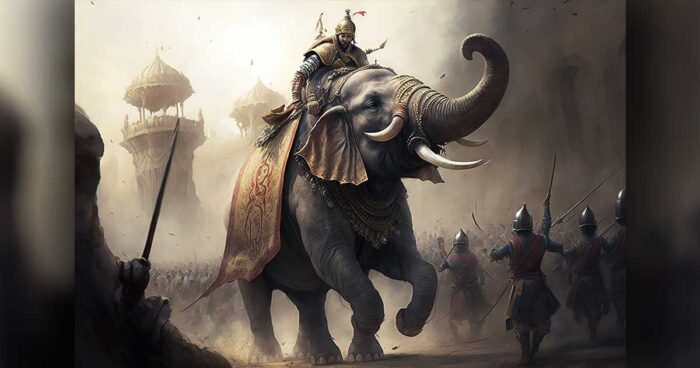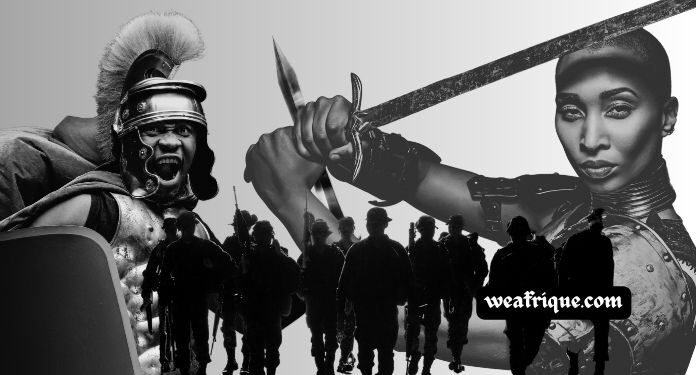Looking into history, we find revelations of grandness, brave warriors, and mighty empires that once ruled Africa. These warriors were from different parts of the continent, and their military prowess continues to take center stage in stories of wars, conquest, quality, solid war-fighting doctrine, and special operations, among other things.
Here are the greatest and most powerful militaries in ancient Africa, their fighting techniques, the wars they fought, and how long they lasted.
Most Powerful Military In Ancient Times in Africa
1. Aksumite Military
The Aksumite military was one of the most powerful militaries in the ancient world, not only in Africa. It was compared to the Roman soldiers of its time and was also one of the four great powers of the 3rd century, alongside Rome, China, and Persia.
The Aksumite military belonged to the Kingdom of Aksum, also known as the Axum Kingdom, which was located in present-day northern Ethiopia, Eritrea, northern Djibouti, eastern Sudan, and Yemen.
The kingdom’s military was divided into Sarawit groups, each of which was controlled by a general called a Nagast. The lowest army at the time was about 3,000 soldiers.
The Aksumite military fought many battles and made great use of animals such as donkeys to transport items to the battlefields, and camels in desert warfare. They also reportedly used elephants in battle.
One of the major territories that the Aksumite military conquered was the powerful Kingdom of Kush in 350 CE. Despite the victories that the kingdom enjoyed for many years, the military was weakened and the Kingdom of Aksum fell around 960 CE when it was defeated by a Jewish queen named Yodit, also known as Judith.
2. Military of Ancient Nubia
The Nubian military was responsible for the wars of Nubia, a region in southern Egypt, and was the seat of African kingdoms such as Kerma, Kush, Nobatia, Makuria, and Alodia.
It was famous for using anciently sophisticated bronze weapons such as swords, axes, spears, armor, and archery. The army also made extensive use of war elephants and siege engines, which contributed to their conquering nations and kingdoms.
The military had a large cavalry, and archers formed the major part of its army.
In the Nubian Kingdom, the Kerma Kingdom or Kerma culture was so strong that its soldiers were sometimes employed by other kingdoms. The military also became instrumental in making the Egyptian state a military power.
By 1000 BC, about 500 years after the end of Kerma, another kingdom called Kush started in Nubia. The Kushite army was one of the strongest and most tactical. It conquered Egypt and formed the 25th dynasty from 744 to 656 BC.
The army was responsible for fighting some major wars with Rome. Some of its most successful fights included defeating three Roman cohorts. Some of the most notable warriors and leaders of the kingdom are King Taharqa and Queen Amanirenas, who became the first African ruler to defeat the legendary Caesar Augustus.
3. The Carthaginian Military

It was one of the largest militaries in the ancient world, consisting of a strong army and navy. The Carthaginian military was active from 550 BC, when Mago I of Carthage became ruler.
In its earliest days, the army comprised about 24,000 infantry, 4,000 cavalry, and 300 war elephants, which were mostly used alongside siege engines, skirmishers, heavy cavalry, and chariots during wars.
The military, which comprised light and heavy infantry, faced defeats in its earliest days, but it quickly reformed and recruited more mercenaries, including Spartan captain Xanthippus, who helped to introduce new skills and more advanced military techniques.
The Carthaginian army was responsible for destroying a number of great Roman armies, including those of the Romans themselves.
Some of their notable fights include their battles with the Greeks for control of the island of Sicily. One of their major fighting skills, the rectangular mass military formation known as the phalanx, was adopted from the Greeks.
Although many commanders rose through the ranks of the military, Hannibal was its most famous military ruler, in 146 BC, while Hamilcar was another notable commander.
See Also: 7 Female Warriors Who Led African Empires and Armies
4. Songhai Military
Songhai had one of the largest and strongest African soldiers of ancient times. The soldiers were of the Songhai empire which is found in West Africa in present-day Niger, Mali, Mauritania, Senegal, Nigeria, Guinea, Gambia, southern Algeria, Burkina-Faso, and Ivory Coast.
The Songhai military had 12,500 cavalry of mounted knights and about 30,000 infantry soldiers, which included freemen and captives. It became the largest military in Africa after the fall of the Mali Empire.
The military became the largest in Africa after the fall of the Mali Empire. It was also known for using armor such as chain mail and helmets similar to those of medieval European armies. Other arsenals used by the ancient military include swords, arrows, and copper or leather shields.
The army was responsible for a major war victory over Timbuktu, which later became the second most important city in Songhai. It also defeated the Dogon and Fulani in the hills of Bandiagara.
Songhai’s military prowess began to decline in the late 16th century. By 1583, the empire had split in two, and the military was further weakened when the Moroccan army invaded Songhai with modern weapons, including guns.
5. Mandakalu Military
The military of the great Mali Empire contributed to how vast the Mali Empire gained ground in Africa. Mali was one of the greatest Empires in Africa and it spread across many parts of West Africa in modern-day Mali, Senegal, southern Mauritania, Guinea-Bissau, Guinea, Ivory Coast, the Gambia, northern Burkina Faso, and Ghana.
Mali’s military was capable of 100,000 regular armies.
The Mali Empire’s military adopted a great part of the Mandinka culture such as blacksmithing which contributed to their having great iron weapons such as lances, sabers, long chains and swords; and iron helmets. They also adopted the use of poisonous spears against their opponents.
The army which had Farima-Soura and Sankaran-Zouma as leaders and operated from 1230 to 1610 fought opponents such as Songhai, Jolof, Mossi, Tuareg, and Fula.
It is mostly remembered for its role in the Battle of Kirina which is also known as the Battle of Krina or Siege of Karina. The war dates as far back as 1235 and it was between the Sosso Empire king Sumanguru Kante and Mandinka prince Sundiata Keita.
The fight became a national epic for Mali as well as its military. It also marked the beginning of the Mali Empire. At the time of Mansa Abubakari I, conquered the ancient state of Tekrour before it enjoyed great peace and wealth in the next century before it was met by violence that started to reduce the strength of the army.
In its last days, it struggled in the fight against the Portuguese and was later largely defeated. According to a number of accounts, Mali may have had good native weapons but were crumbled for lack of gunpowder.
The military and empire received their last defeat in the 17th century and the empire was destroyed by the Bambara.
6. Dahomey Amazon
Also known as Dahomey Mino, Agojie, Agoji, or Minon, these African warriors were an all-female military regiment of the Dahomey Kingdom in present-day Benin in West Africa.
They existed from the 1600s to the late 1800s and are among the few documented female armies in history.
The women soldiers started their existence when the kingdom suffered several attacks and their male soldiers were highly injured while others were killed.
These women soldiers who called themselves “ahosi” which means the king’s wives had to go through rigorous training and in their early days were between 1,000 and 6,000.
Dahomey Amazon had different regiments ranging from huntresses to riflewomen, reapers, archers, and gunners.
They fought using hand-to-hand technique and conquered several lands until their glory started to diminish after they were heavily defeated by Abeokuta warriors.
Subsequently, they engaged in the First Franco-Dahomean War in the 19th century with France when their territory was invaded by the French. Although it has been recorded that their hand-to-hand fight was remarkable, the French had more weapons and the Amazon faced defeat with many of them killed.
Also in the second Franco-Dahomean War, the Dahomey Amazon faced a more brutal defeat, and by 1894, they disbanded and Dahomey became a French protectorate.
In the present time, the African warriors, Dahomey Amazon have been depicted in many literary works. One of the most popular is a Hollywood film, The Woman King, directed by Gina Prince-Bythewood and featuring Viola Davis, Thuso Mbedu, Lashana Lynch, Sheila Atim, Hero Fiennes Tiffin, and John Boyega.
7. Zulu Military
The Zulu military remains one of the most recorded and great militaries in Africa’s history. They were the soldiers of the Zulu Kingdom in southern Africa and the most popular in the region.
The kingdom started as a very small one until a warrior named Shaka became a ruler. He then led the small kingdom to many fights and mostly came out victorious.
With many of the Zulu military victories, their kingdom expanded and more warriors were recruited. The military was known for its strong fighting spirit and was divided into regiments starting from young boys at the early age of 6 to commanders.
The soldiers were said to have received rigorous training and may be killed whenever they failed at wars, objected to some of Shaka’s rulings, or even lost sound. This contributed to how fierce the Zulu military became.
The military was famous for using heavy-bladed and short-shafted stabbing bears while many tribes at the time used long spindly throwing spears. They also used heavier cowhide shields called isihlangu.
Their most used fighting method was hand-to-hand combat while stabbing their enemies with a stabbing spear called ikiwa. They also attack their enemies using a long spear as well as a hardwood known as iwisa which was used for beating enemies.




















